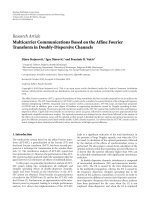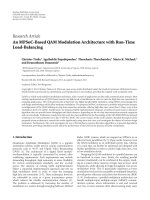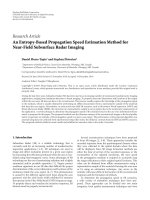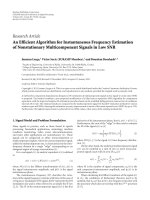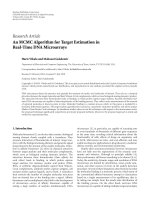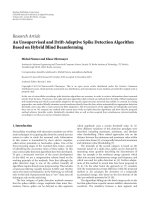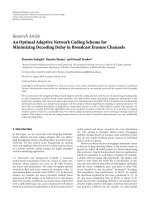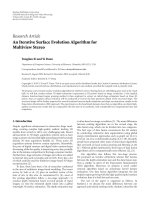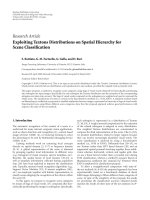Báo cáo hóa học: " Research Article An Algorithm Based on Resolvant Operators for Solving Positively Semidefinite Variational Inequalities" doc
Bạn đang xem bản rút gọn của tài liệu. Xem và tải ngay bản đầy đủ của tài liệu tại đây (561.63 KB, 15 trang )
Hindawi Publishing Corporation
Fixed Point Theory and Applications
Volume 2007, Article ID 76040, 15 pages
doi:10.1155/2007/76040
Research Article
An Algorithm Based on Resolvant Operators for Solving
Positively Semidefinite Variational Inequalities
Juhe Sun, Shaowu Zhang, and Liwei Zhang
Received 16 June 2007; Accepted 19 September 2007
Recommended by Nan-Jing Huang
A new monotonicity, M-monotonicity, is introduced, and the resolvant operator of an
M-monotone operator is proved to be single-valued and Lipschitz continuous. With the
help of the resolvant operator, the positively semidefinite general var iational inequality
(VI) problem VI (S
n
+
,F + G) is transformed into a fixed point problem of a nonexpan-
sive mapping. And a proximal point algorithm is constructed to solve the fixed point
problem, which is proved to have a global convergence under the condition that F in the
VI problem is strongly monotone and Lipschitz continuous. Furthermore, a convergent
path Newton method is given for calculating
-solutions to the sequence of fixed point
problems, enabling the proximal point algorithm to be implementable.
Copyright © 2007 Juhe Sun et al. This is an open access article distributed under the Cre-
ative Commons Attribution License, which permits unrestricted use, distribution, and
reproduction in any medium, provided the original work is properly cited.
1. Introduction
In recent years, the variational inequality has been addressed in a large variety of prob-
lems arising in elasticity, structural analysis, economics, transportation equilibrium, op-
timization, oceanography, and engineering sciences [1, 2]. Inspired by its wide applica-
tions, many researchers have studied the classical variational inequality and generalized it
in various directions. Also, many computational methods for solving variational inequal-
ities have been proposed (see [3–8] and the references therein). Among these methods,
resolvant operator technique is an important one, which was studied in the 1990s by
many researchers (such as [4, 6, 9]), and further studies developed recently [3, 10, 11].
As monotonicity plays an important role in the theory of variational inequality and
its generalizations, in this paper, we introduce a new class of monotone operator: M-
monotone operator. The resolvant operator associated with an M-monotone operator is
2 Fixed Point Theory and Applications
proved to be Lipschitz-continuous. Applying the resolvant operator technique, we trans-
form the positively semidefinite variational inequality (VI)problemVI(S
n
+
,F + G)into
a fixed point problem of a nonexpansive mapping and suggest a proximal point algo-
rithm to solve the fixed point problem. Under the condition that F in the VI problem is
strongly monotone and Lipschitz-continuous, we prove that the algorithm has a global
convergence. To ensure the proposed proximal point algorithm is implementable, we in-
troduce a path Newton algor ithm whose step size is calculated by Armijo rule.
In the next section, we recall some results and concepts that will be used in this paper.
In Section 3, we introduce the definition of an M-monotone operator, and discuss prop-
erties of this kind of operators, especially the Lipschitz continuity of the resolvant opera-
tor of an M-monotone operator. In Section 4, we construct a proximal point algorithm,
based on the results in Section 3,forVI(S
n
+
,F + G), and prove its global convergence. To
ensure that the proposed proximal point algorithm in Section 4 is implementable, we in-
troduce a path Newton algorithm, in Section 5, in which the step size is calculated by
Armijo rule.
2. Preliminaries
Throughout this paper, we assume that S
n
denotes the space of n × n symmetric matrices
and S
n
+
denote the cone of n × n symmetric positive semidefinite matrices. For A,B ∈ S
n
,
we define an inner product
A,B=tr(AB) which induces the norm A=
A,A.Let
2
S
n
denote the family of all the nonempty subsets of S
n
. We recall the following concepts,
which will be used in the sequel.
Definit ion 2.1. Let A,B,C : S
n
→ S
n
be single-valued operators and let M : S
n
× S
n
→ S
n
be
mapping.
(i) M(A,
·)issaidtobeα-strongly monotone with respect to A if there exists a con-
stant α>0 satisfying
M(Ax,u) − M(Ay,u),x − y
≥
αx − y
2
, ∀x, y,u ∈ S
n
; (2.1)
(ii) M(
·,B)issaidtobeβ-relaxed monotone with respect to B if there exists a constant
β>0 satisfying
M(u,Bx) − M(u,By), x − y
≥−
βx − y
2
, ∀x, y,u ∈ S
n
; (2.2)
(iii) M(
·,·)issaidtobeαβ-symmetric monotone with respect to A and B if M(A,·)is
α-strongly monotone with respect to A;andM(
·,B)isβ-relaxed monotone w ith
respect to B with α
≥ β and α = β if and only if x = y,forallx, y,u ∈ S
n
;
(iv) M(
·,·)issaidtobeξ-Lipschitz-continuous with respect to the first argument if
there exists a constant ξ>0 satisfying
M(x, u) − M(y,u)
≤
ξx − y, ∀x, y,u ∈ S
n
; (2.3)
Juhe Sun et al. 3
(iv) A is said to be t-Lipschitz-continuous if there exists a constant t>0 satisfying
Ax − Ay≤tx − y, ∀x, y ∈ S
n
; (2.4)
(vi) B is said to be l-cocoercive if there exists a constant l>0 satisfying
Bx − By,x − y≥lBx− By
2
, ∀x, y ∈ S
n
; (2.5)
(vii) C is said to be r-strongly monotone with respect to M(A,B) if there exists a con-
stant r>0 satisfy ing
Cx − Cy,M(Ax, Bx) − M(Ay,By)
≥
rx − y
2
, ∀x, y ∈ S
n
. (2.6)
In a similar way to (v), we can define the Lipschitz continuity of the mapping M with
respect to the second argument.
Definit ion 2.2. Let A,B : S
n
→ S
n
, M : S
n
× S
n
→ S
n
be mappings. M is said to be coercive
with respect to A and B if
lim
x→∞
M(Ax,Bx),x
x
=
+∞. (2.7)
Definit ion 2.3. Let A,B : S
n
→ S
n
, M : S
n
× S
n
→ S
n
be mappings. M is said to be bounded
with respect to A and B if M(A(P),B(P)) is bounded for every bounded subset P of S
n
.
M is said to be semicontinuous with respect to A and B if for any fixed x, y,z
∈ S
n
,the
function t
→M(A(x + ty),B(x + ty)),z is continuous at 0
+
.
Definit ion 2.4. T : S
n
→ 2
S
n
is said to be monotone if
x − y,u − v≥0, ∀u,v ∈ S
n
, x ∈ Tu, y ∈ Tv; (2.8)
and it is said to be maximal monotone if T is monotone and (I + cT)(S
n
) = S
n
for all
c>0, where I denotes the identity mapping on S
n
.
3. M-Monotone operators
In this section, we introduce M-monotonicity of operators and discuss its properties.
Definit ion 3.1. Let A,B : S
n
→ S
n
be single-valued operators, M : S
n
× S
n
→ S
n
amapping,
and T : S
n
→ 2
S
n
amultivalueoperator.T is said to be M-monotone with respect to A and
B if T is monotone and (M(A,B)+cT)(S
n
) = S
n
holds for every c>0.
Remark 3.2. If M(A,B)
= H, then the above definition reduces to H-monotonicity, which
was studied in [5]. If M(A,B)
= I, then the definition of I-monotonicity is just the maxi-
mal monotonicity.
Remark 3.3. Let T be a monotone operator and let c be a positive constant. If T : S
n
→ 2
S
n
is an M-monotone operator w ith respect to A and B,everymatrixz ∈ S
n
can be written
in exactly one way as M(Ax,Bx)+cu,whereu
∈ T(x).
4 Fixed Point Theory and Applications
Proposition 3.4. Let M be αβ-symmetric monotone with respect to A and B and let T :
S
n
→ 2
S
n
be an M-monotone operator with respect to A and B, then T is maximal monotone.
Proof. Since T is monotone, it is sufficient to prove the following property; inequality
x − y,u − v≥0for(v, y) ∈ Graph(T) implies that
x
∈ Tu. (3.1)
Suppose, by contradiction, that there exists some (u
0
,x
0
)∈Graph(T)suchthat
x
0
− y,u
0
− v
≥
0, ∀(v, y) ∈ Graph(T). (3.2)
Since T is M-monotone with respect to A and B,(M(A,B)+cT)(S
n
) = S
n
holds for every
c>0, there exists (u
1
,x
1
) ∈ Graph(T)suchthat
M
Au
1
,Bu
1
+ cx
1
= M
Au
0
,Bu
0
+ cx
0
∈ S
n
. (3.3)
It follows form (3.2)and(3.3)that
0
≤ c
x
0
− x
1
,u
0
− u
1
=−
M
Au
0
,Bu
0
−
M
Au
1
,Bu
1
,u
0
− u
1
=−
M
Au
0
,Bu
0
−
M
Au
1
,Bu
0
,u
0
− u
1
−
M
Au
1
,Bu
0
−
M
Au
1
,Bu
1
,u
0
− u
1
≤−
(α − β)
u
0
− u
1
≤
0,
(3.4)
which yields u
1
= u
0
.By(3.3), we have that x
1
= x
0
.Hence(u
0
,x
0
) ∈ Graph(T), which is
a contradiction. Therefore (3.1)holdsandT is maximal monotone. This completes the
proof.
The following example shows that a maximal monotone operator may not be M-
monotone for some A and B.
Example 3.5. Let S
n
= S
2
, T = I,andM(Ax, Bx) = x
2
+2E − x for all x ∈ S
2
,whereE is an
identity matrix. Then it is easy to see that I is maximal monotone. For all x
∈ S
2
,wehave
that
M(A,B)+I
(x)
2
=
x
2
+2E − x + x
2
=
x
2
+2E
2
= tr
x
2
+2E
2
≥
8, (3.5)
which means that 0
¯
∈(M(A,B)+I)(S
2
)andI is not M-monotone with respect to A and
B.
Proposition 3.6. Let T : S
n
→ 2
S
n
be a maximal monotone operator and let M : S
n
× S
n
→
S
n
be a bounded, coercive, semicontinuous, and αβ-symmetric monotone operator with re-
spect to A and B. Then T is M-monotone with respect to A and B.
Proof. For every c>0, cT is maximal monotone since T is maximal monotone. Since M is
bounded, coercive, semicontinuous, and αβ-symmetric monotone operator with respect
Juhe Sun et al. 5
to A and B,itfollowsfrom[9, Corollary 32.26] that M(A, B)+cT is surjective, that is,
(M(A,B)+cT)(S
n
) = S
n
holds for every c>0. Thus, T is an M-monotone operator with
respect to A and B. The proof is complete.
Theorem 3.7. Let M be an αβ-symmetric monotone with respect to A and B and let T be
an M-monotone operator with respect to A and B. Then the operator (M(A,B)+cT)
−1
is
single-valued.
Proof. For any given u
∈ S
n
,letx, y ∈ (M(A,B)+cT)
−1
(u). It follows that −M(Ax,Bx)+
u
∈ Tx and −M(Ay,By)+u ∈ Ty. The monotonicity of T and M implies that
0
≤
− M(Ax,Bx)+u −
− M(Ay,By)+u
,x − y
=−
M(Ay,By) − M(Ax,Bx),x − y
≤−
(α − β)
u
0
− u
1
≤
0.
(3.6)
From the symmetric monotonicity of M,wegetthatx
= y.Thus(M(A,B)+cT)
−1
is
single-valued. This completes the proof.
Definit ion 3.8. Let M be an αβ-symmetric monotone with respect to A and B and let T be
an M-monotone operator with respect to A and B. The resolvant operator J
M
cT
: S
n
→ S
n
is
defined by
J
M
cT
(u) =
M(A,B)+cT
−1
(u), ∀u ∈ S
n
. (3.7)
Theorem 3.9. Let M(A,B) be α-strongly monotone with respect to A and β-relaxed mono-
tone with respect to B with α>β.SupposethatT : S
n
→ 2
S
n
is an M-monotone operator.
Then the resolvant operator J
M
cT
: S
n
→ S
n
is Lipschitz-continuous with constant 1/(α − β),
that is,
J
M
cT
(u) − J
M
cT
(v)
≤
1
α − β
u − v, ∀u,v ∈ S
n
. (3.8)
Since the proof of Theorem 3.9 is similar as that of [5, Theorem 2.2], we here omit it.
4. An algorithm for variational inequalities
Let F,G : S
n
+
→ S
n
be operators. Consider the general variational inequality problem
VI(S
n
+
,F + G), defined by finding u ∈ S
n
+
such that
F(u)+G(u),v − u
≥
0, ∀v ∈ S
n
+
. (4.1)
We can rewrite it as the problem of finding u
∈ S
n
+
such that
0
∈ G(u)+T(u), (4.2)
where T
≡ F + ᏺ(·;S
n
+
). Let Sol(S
n
+
,F + G) be the set of solutions of VI(S
n
+
,F + G).
6 Fixed Point Theory and Applications
Proposition 4.1. Let F,G : S
n
+
→ S
n
be continuous and let M : S
n
× S
n
→ S
n
be a bounded,
coercive, semicontinuous, and αβ-symmetric monotone operator with respect to A : S
n
→ S
n
and B : S
n
→ S
n
. Then the following two properties hold for the map T ≡ F + ᏺ(·;S
n
+
):
(a) J
M
cT
(M(Ax,Bx) − cG(x))=Sol(S
n
+
,F
cx
),whereF
cx
(y) = M(Ay,By) − M(Ax, Bx)+
c(F(y)+G(x));
(b) If F is monotone, then T is M-monotone with respect to A and B.
Proof. We have that the inclusion
y
∈ J
M
cT
M(Ax,Bx) − cG(x)
=
M(A,B)+cT
−1
M(Ax,Bx) − cG(x)
(4.3)
is equivalent to
M(Ax,Bx)
∈
M(A,B)+cF + cᏺ
·
;S
n
+
(y)+cG(x), (4.4)
or in other words,
0
∈ M(Ay,By) − M(Ax,Bx)+c
F(y)+G(x)
+ ᏺ
y;S
n
+
. (4.5)
This establishes (a).
By [10, Proposition 12.3.6], we can deduce that T is maximal monotone, it follows
from Proposition 3.6,wegetthatT is M-monotone with respect to A and B. This com-
pletes the proof.
Lemma 4.2. Let M be an αβ-symmetric monotone with respect to A and B and let T be an
M-monotone operator with respect to A and B. Then u
∈ S
n
+
is a solution of 0 ∈ G(u)+T(u)
if and only if
u
= J
M
cT
M(Au,Bu) − cG(u)
, (4.6)
where J
M
cT
= (M(A,B)+cT)
−1
and c>0 is a constant.
In order to obtain our results, we need the following assumption.
Assumption 4.3. The mappings F, G, M, A, B satisfy the following conditions.
(1) F is L-Lipschitz-continuous and m-strongly monotone.
(2) M(A,
·) is α-strongly monotone with respect to A;andM(·,B) is β-relaxed monotone
with respect to B with α>β.
(3) M(
·,·) is ξ-Lipschitz-continuous with respect to the first argument and ζ-Lipschitz-
continuous with respect to the second argument.
(4) A is τ-Lipschitz-continuous and B is t-Lipschitz-continuous.
(5) G is γ-Lipschitz-continuous and s-strongly monotone with respect to M(A,B).
Remark 4.4. Let Assumption 4.3 hold and
c −
s
γ
2
≤
s
2
− γ
2
(ξτ + ζt)
2
− (α − β)
2
γ
2
, s
2
>γ
2
(ξτ + ζt)
2
− (α − β)
2
. (4.7)
Juhe Sun et al. 7
Wecandeducethat
J
M
cT
M(Ax,Bx) − cG(x)
−
J
M
cT
M(Ay,By) − cG(y)
≤
1
α − β
M(Ax,Bx) − M(Ay,By) − c
G(x) − G(y)
≤
(ξτ + ζt)
2
− 2cs + c
2
γ
2
α − β
x − y
≤
x − y,
(4.8)
which implies that J
M
cT
(M(A,B) − cG) is nonexpansive. Then, it is natural to consider the
recursion
x
k+1
≡ J
M
cT
M
Ax
k
,Bx
k
−
cG
x
k
, (4.9)
which is desired to converge to a zero of G + T.Actually,thiscanbeprovedtobetrue.
However, based on Lemma 4.2, we construct the following proximal point algorithm for
VI(S
n
+
,F + G).
Algorithm 4.5
Data. x
0
∈ S
n
, c
0
> 0, ε
0
≥ 0,andρ
0
> 0.
Step 1. Set k
= 0.
Step 2. If x
k
∈ Sol(S
n
+
,F + G),stop.
Step 3. Find w
k
such that w
k
− J
M
c
k
T
(M(Ax
k
,Bx
k
) − c
k
G(x
k
))≤ε
k
.
Step 4. Set x
k+1
≡ (1 − ρ
k
)x
k
+ ρ
k
w
k
and select c
k+1
, ε
k+1
and ρ
k+1
.Setk ← k +1and go to
Step 1.
The following theorem fully describes the convergence of Algorithm 4.5 for finding a
solution to VI(S
n
+
,F + G).
Theorem 4.6. Suppose that Algorithm 4.5 holds. Let M be bounded, coercive, semicon-
tinuous, and αβ-symmetric monotone with respect to A and B;andletF be monotone
and Lipschitz-continuous. Let x
0
∈ S
n
be given, let {ε
k
}⊂[0,∞) satisfy E ≡
∞
k=1
ε
k
< ∞,
{c
k
}⊂(c
m
,∞),wherec
m
> 0 and
c
k
−
s
γ
2
<
s
2
− γ
2
(ξτ + ζt)
2
− (α − β)
2
γ
2
, s
2
>γ
2
(ξτ + ζt)
2
− (α − β)
2
, (4.10)
which implies that
L =
α − β −
(ξτ + ζt)
2
− 2c
k
s + c
2
k
γ
2
α − β +3
(ξτ + ζt)
2
− 2c
k
s + c
2
k
γ
2
2
> 0. (4.11)
If
{ρ
k
}⊆[R
m
,R
M
],where0 <R
m
≤ R
M
≤ p
L,forallp ∈ [2,+∞), then the sequence {x
k
}
generated by Algorithm 4.5 convergestoasolutionofVI(S
n
+
,F + G).
8 Fixed Point Theory and Applications
Proof. We introduce a new map
Q
k
≡ I − J
M
c
k
T
M(A,B) − c
k
G
. (4.12)
Clearly, any zero of G + F + ᏺ(
·;S
n
+
), being a fixed point of J
M
c
k
T
(M(A,B) − c
k
G), is also a
zero of Q
k
.Now,letusprovethatQ
k
is
L-cocoercive.
For x, y
∈ S
n
we know that
Q
k
(x) − Q
k
(y),x − y
=
x − y −
J
M
c
k
T
M(Ax,Bx) − c
k
G(x)
−
J
M
c
k
T
M(Ay,By) − c
k
G(y)
,x − y
=
x − y
2
−
J
M
c
k
T
M(Ax,Bx)
−
J
M
c
k
T
M(Ay,By) − c
k
G(x) − G(y)
,x − y
≥
x − y
2
−
1
α − β
M(Ax,Bx) − M(Ay,By) − c
k
G(x) − G(y)
x − y
≥
x − y
2
−
1
α − β
(ξτ + ζt)
2
− 2c
k
s + c
2
k
γ
2
x − y
2
=
1 −
(ξτ + ζt)
2
− 2c
k
s + c
2
k
γ
2
α − β
x − y
2
,
(4.13)
Q
k
(x) − Q
k
(y)
2
=
x − y −
J
M
c
k
T
M(Ax,Bx) − c
k
G(x)
−
J
M
c
k
T
M(Ay,By) − c
k
G(y)
2
=x − y
2
− 2
x − y,J
M
c
k
T
M(Ax,Bx) − c
k
G(x)
−
J
M
c
k
T
M(Ay,By) − c
k
G(y)
+
J
M
c
k
T
M(Ax,Bx) − c
k
G(x)
−
J
M
c
k
T
M(Ay,By) − c
k
G(y)
2
≤x − y
2
+2
(ξτ + ζt)
2
− 2c
k
s + c
2
k
γ
2
α − β
x − y
2
+
(ξτ + ζt)
2
− 2c
k
s + c
2
k
γ
2
α − β
x − y
2
=
⎛
⎝
1+3
(ξτ + ζt)
2
− 2c
k
s + c
2
k
γ
2
α − β
⎞
⎠
x − y
2
.
(4.14)
Inequalities (4.13)and(4.14)implythat
Q
k
(x) − Q
k
(y),x − y
≥
⎡
⎣
1−
(ξτ + ζt)
2
− 2c
k
s + c
2
k
γ
2
α − β
⎤
⎦
⎡
⎣
1+3
(ξτ + ζt)
2
− 2c
k
s + c
2
k
γ
2
α − β
⎤
⎦
−1
Q
k
(x)−Q
k
(y)
2
=
L
Q
k
(x) − Q
k
(y)
2
.
(4.15)
Juhe Sun et al. 9
For all k, we denote by
x
k
the point computed exactly by the resolvent. That is,
x
k+1
≡
1 − ρ
k
x
k
+ ρ
k
J
M
c
k
T
M
Ax
k
,Bx
k
−
c
k
G
x
k
. (4.16)
For every zero x
∗
of T,weobtain
x
k+1
− x
∗
2
=
x
k
− ρ
k
Q
k
x
k
−
x
∗
2
=
x
k
− x
∗
2
− 2ρ
k
Q
k
x
k
−
Q
k
x
∗
,x
k
− x
∗
+ ρ
2
k
Q
k
x
k
2
≤
x
k
− x
∗
2
− 2ρ
k
L
Q
k
x
k
2
+ ρ
2
k
Q
k
x
k
2
≤
x
k
− x
∗
2
− ρ
k
2
L − ρ
k
Q
k
x
k
2
≤
x
k
− x
∗
2
− R
m
2
L − R
M
Q
k
x
k
2
≤
x
k
− x
∗
2
.
(4.17)
Since
x
k
− x
k
≤ρ
k
ε
k
,wegetthat
x
k+1
− x
∗
≤
x
k+1
− x
∗
+
x
k+1
− x
k+1
≤
x
k
− x
∗
+ ρ
k
ε
k
≤
x
0
− x
∗
+
k
i=0
ρ
i
ε
i
≤
x
0
− x
∗
+ p
LE.
(4.18)
Therefore, the sequence
{x
k
} is bounded. On the other hand, we have that
x
k+1
− x
∗
2
=
x
k+1
− x
∗
+
x
k+1
− x
k+1
2
=
x
k+1
− x
∗
2
+2
x
k+1
− x
∗
,x
k+1
− x
k+1
+
x
k+1
− x
k+1
2
≤
x
k+1
− x
∗
2
+2
x
k+1
− x
∗
x
k+1
− x
k+1
+
x
k+1
− x
k+1
2
≤
x
k
− x
∗
2
+2ρ
k
ε
k
x
0
− x
∗
+ p
LE
+ ρ
2
k
ε
2
k
− R
m
2
L − R
M
Q
k
x
k
2
.
(4.19)
Letting E
2
=
∞
i=0
ε
2
k
< ∞,wehaveforeveryk,
x
k+1
− x
∗
2
≤
x
0
− x
∗
2
+2p
LE
x
0
− x
∗
+ p
LE
+ p
2
L
2
E
2
− R
m
2
L − R
M
k
i=0
Q
k
x
k
2
.
(4.20)
Passing to the limit k
→∞, one has that
∞
i=0
Q
k
(x
k
)
2
< ∞, implying that
lim
k→∞
Q
k
x
k
=
0. (4.21)
10 Fixed Point Theory and Applications
According to Remark 3.3,foreveryk, there exists a unique pair (y
k
,v
k
)ingphT
such that z
k
= M(Ax
k
,Bx
k
) − c
k
G(x
k
) = M(Ay
k
,By
k
)+c
k
v
k
.ThenJ
M
c
k
T
(M(Ax
k
,Bx
k
) −
c
k
G(x
k
)) = y
k
.SothatQ
k
(x
k
) → 0 implies that (x
k
− y
k
) → 0, v
k
→ 0.
Since c
k
is bounded away from zero, it follows that c
−1
k
Q
k
(x
k
) → 0. Since x
k
is bounded,
it has at least a limit point. Let x
∞
be such a limit point and assume that the subse-
quence
{x
k
i
: k
i
∈ k} converges to x
∞
. It follows that {y
k
i
: k
i
∈ k} also converges to x
∞
.
For every (y,v)ingphT by the monotonicity of T,wehavethat
y − y
k
,v − v
k
≥0. Let-
ting k
i
(∈ k) →∞,wegetthaty − y
∞
,v − v
k
≥0. We see that T is M-monotone due to
Proposition 4.1, this implies that (x
∞
,−G(x
∞
)) ∈ gphT, that is, −G(x
∞
) ∈ T(x
∞
). This
completes the proof.
5. Solving an approximate fixed point to J
M
c
k
T
How to calculate w
k
at Step 3 is the key in Algorithm 4.5.Ifε
k
= 0, this amounts to the
exact solution of VI(S
n
+
,F
k
), where
F
k
(x) = M(Ax,Bx) − M
Ax
k
,Bx
k
+ c
k
F(x)+G(x
k
. (5.1)
Now, we consider the case of ε
k
> 0. We can prove that J
M
c
k
T
(M(Ax
k
,Bx
k
) − c
k
G(x
k
)) is
the unique solution of the VI(S
n
+
,F
k
). Hence, w
k
is an inexact solution of the VI(S
n
+
,F
k
)
satisfying dist(w
k
,Sol(S
n
+
,F
k
)) ≤ ε
k
.
Lemma 5.1. Let F, G, M, A, B satisfy all the conditions of Assumption 4.3. Then a constant
c(k) > 0 exists such that
dist
w
k
,Sol
S
n
+
,F
k
≤
c(k)
F
k
nat
S
n
+
w
k
. (5.2)
Proof. By Assumption 4.3, we can easily get that F
k
is L
(k)-Lipschitz-continuous and
η(k)-strongly monotone, where L
(k) = ξτ + ζt+c
k
L and η(k) = α − β + c
k
m, that is,
F
k
(x) − F
k
(y)
≤
L
(k)
x − y
,
F
k
(x) − F
k
(y),x − y
≥
η(k)x − y
2
, ∀x, y ∈ S
n
+
.
(5.3)
Let r
= (F
k
)
nat
S
n
+
(w
k
), where (F
k
)
nat
S
n
+
is the natural map associated with the VI(S
n
+
,F
k
). We
have that w
k
− r = Π
S
n
+
(w
k
− F
k
(w
k
)), that is,
y − w
k
+ r, F
k
w
k
−
r
≥
0, ∀y ∈ S
n
+
. (5.4)
For all x
∗
∈ Sol(S
n
+
,F
k
)andw
k
− r ∈ S
n
+
,wealsohavethat
w
k
− r − x
∗
,F
k
x
∗
≥
0. (5.5)
From (5.4)and(5.5), we get that
x
∗
− w
k
,F
k
w
k
−
r
+
r,F
k
w
k
−
r
=
x
∗
− w
k
,F
k
w
k
−
x
∗
− w
k
,r
+
r,F
k
w
k
+
r
2
≥ 0,
(5.6)
x
∗
− w
k
,F
k
x
∗
−
r,F
k
x
∗
≥
0.
(5.7)
Juhe Sun et al. 11
Adding (5.6)and(5.7), we deduce that
η(k)
w
k
− x
∗
2
≤
x
∗
− w
k
,F
k
w
k
−
F
k
x
∗
≤−
w
k
− x
∗
,r
−
r
2
+
r,F
k
x
∗
−
F
k
w
k
≤
r
w
k
− x
∗
+ rL
(k)
w
k
− x
∗
=
1+L
(k)
w
k
− x
∗
r.
(5.8)
Hence,
w
k
− x
∗
≤η(k)
−1
(1 + L
(k))r. This implies that
dist
w
k
,Sol
S
n
+
,F
k
≤
c(k)
F
k
nat
S
n
+
w
k
, (5.9)
where c(k)
= η(k)
−1
(1 + L
(k)). This completes the proof.
Consequently, the computation of w
k
can be accomplished by obtaining an inexact
solution of VI(S
n
+
,F
k
) satisfy ing the residual condition
F
k
nat
S
n
+
w
k
≤
1
c(k)
ε
k
. (5.10)
We note that the operator
S
n
+
(·)isdirectionallydifferentiable and strongly s emismooth
everywhere (see, e.g., [12]). If F
k
(·)iscontinuouslydifferentiable, then we get that
F
k
nat
S
n
+
(w) = w −
S
n
+
w − F
k
(w)
(5.11)
is directionally differentiable.
In what follows, we present the following path Newton method for solving the equa-
tion (F
k
)
nat
S
n
+
(w
k
) = 0.
Algorithm 5.2
Data. w
0
∈ S
n
, γ ∈ (0,1),andρ ∈ (0,1).
Step 1. Set j
= 0.
Step 2. If (F
k
)
nat
S
n
+
(w
j
) = 0,stop.
Step 3. Select an element V
j
∈ ∂[(F
k
)
nat
S
n
+
(w
j
)] and consider the corresponding path p
j
(·) =
w
j
− (·)V
−1
j
(F
k
)
nat
S
n
+
(w
j
) with domain I
j
= [0,
¯
τ
j
) for some
¯
τ
j
∈ (0,1]. Find the smallest non-
negative integer i
j
such that with i = i
j
, ρ
i
¯
τ
j
∈ I
j
and
F
k
nat
S
n
+
p
j
ρ
i
¯
τ
j
≤
1 − γρ
i
¯
τ
j
F
k
nat
S
n
+
w
j
. (5.12)
Step 4. Set τ
j
= ρ
i
j
¯
τ
j
, w
j+1
= p
j
(τ
j
),andj ← j +1;gotoStep2.
Theorem 5.3. Let F, G, M, A,andB satisfy all the conditions of Assumption 4.3.Iffor
all w
∈ S
n
+
every matrix in ∂[(F
k
)
nat
S
n
+
(w)] is nonsingular, then the sequence {w
j
} generated
by Algorithm 5.2 has at least one accumulation point and every accumulation point of the
sequence
{w
j
} is the zero point of (F
k
)
nat
S
n
+
.
12 Fixed Point Theory and Applications
Proof. The nonnegative sequence
{(F
k
)
nat
S
n
+
(w
j
)} is monotonically decreasing; thus it is
bounded. It follows from Lemma 5.1 that the sequence
{w
j
} is bounded. That implies
that
{w
j
} has at least one accumulation point.
Assume that there exists a subsequence
{w
j
m
} of {w
j
} converging to w
∗
such that
F
k
nat
S
n
+
w
∗
=
0, (5.13)
that is, there exist positive constants δ and η satisfying
F
k
nat
S
n
+
w
j
m
≥
η, ∀w
j
m
∈ B
w
∗
,δ
. (5.14)
By the strong semismoothness of (F
k
)
nat
S
n
+
,wehavethat
F
k
nat
S
n
+
(w + h) −
F
k
nat
S
n
+
(w) − V(h) = O
h
2
, ∀w ∈ B
w
∗
,δ
, h ∈ S
n
+
, (5.15)
where V
∈ ∂(F
k
)
nat
S
n
+
(w) is nonsingular and there is a positive constant c such that
sup
w∈B(w
∗
,δ)
V
∈∂(F
k
)
nat
S
n
+
(w)
max
V,
V
−1
≤
c. (5.16)
Letting τ
∈ (0,
¯
τ
j
m
), h = p
j
m
(τ) − w
j
m
,andV
j
m
∈ ∂[(F
k
)
nat
S
n
+
(w
j
m
)], we have that
V
j
m
p
j
m
(τ) − w
j
m
=
F
k
nat
S
n
+
p
j
m
(τ)
−
F
k
nat
S
n
+
w
j
m
−
O
p
j
m
(τ) − w
j
m
2
. (5.17)
It follows that
F
k
nat
S
n
+
p
j
m
(τ)
−
V
j
m
p
j
m
(τ) − w
j
m
−
F
k
nat
S
n
+
w
j
m
p
j
m
(τ) − w
j
m
=
O
p
j
m
(τ) − w
j
m
2
p
j
m
(τ) − w
j
m
.
(5.18)
So we can choose a positive t
∗
small enough so that
o(t)
t
≤
1 − γ
c
,
∀t ∈
0,t
∗
. (5.19)
From the definition of p
j
m
, we know that there exists a constant τ
∗
∈ (0,
¯
τ
j
m
] small enough
so that
p
j
m
(τ) − w
j
m
≤t
∗
,forallτ ∈ (0,τ
∗
], which implies that
o
p
j
m
(τ) − w
j
m
p
j
m
(τ) − w
j
m
≤
1 − γ
c
,
∀τ ∈
0,τ
∗
. (5.20)
It follows from (5.16), (5.18), (5.19), and (5.20)that
F
k
nat
S
n
+
p
j
m
(τ)
≤
V
j
m
p
j
m
(τ) − w
j
m
+
F
k
nat
S
n
+
w
j
m
+
p
j
m
(τ) − w
j
m
o
p
j
m
(τ) − w
j
m
p
j
m
(τ) − w
j
m
≤
(1 − τ)
F
k
nat
S
n
+
w
j
m
+ τ
V
−1
j
m
F
k
nat
S
n
+
w
j
m
1 − γ
c
≤ (1 − τγ)
F
k
nat
S
n
+
w
j
m
, ∀τ ∈ (0,τ
∗
].
(5.21)
Juhe Sun et al. 13
Consequently,
F
k
nat
S
n
+
p
j
m
(τ)
≤
(1 − τγ)
F
k
nat
S
n
+
w
j
m
, ∀τ ∈ (0,τ
∗
]. (5.22)
By the definition of the step-size τ
j
m
, it follows that there exists ξ ∈ (0,τ
∗
)suchthatτ
j
m
≥
ξ for all j
m
. Indeed, if no such ξ exists, then {τ
j
m
} converges to zero. This implies that the
sequence of integers
{i
j
m
} is unbounded. Consequently, by the definition of i
j
m
,wehave,
for all j
m
sufficiently large,
F
k
nat
S
n
+
p
k
ρ
i
j
m
−1
¯
τ
k
>
1 − γρ
i
j
m
−1
¯
τ
k
F
k
nat
S
n
+
w
k
; (5.23)
but this contradicts (5.22)withτ
≡ ρ
i
j
m
−1
¯
τ
j
m
. Consequently, the desired ξ exists. The in-
equality (5.22) implies that
F
k
nat
S
n
+
w
j
m+1
≤
1 − τ
j
m
γ
F
k
nat
S
n
+
w
j
m
. (5.24)
Passing to the limit m
→∞, we deduce a contradiction because lim
m→∞
(F
k
)
nat
S
n
+
(w
j
m
)≥
η>0 and the sequence {τ
j
m
} is bounded away from zero. This yields that (F
k
)
nat
S
n
+
(w
∗
) = 0.
This completes the proof.
Remark 5.4. As stated above, Algorithm 5.2 generates a sequence converging to the zero
point of (F
k
)
nat
S
n
+
,Step3inAlgorithm 4.5 is implementable. Obviously, Algorithm 5.2 stops
within a finite number of iterations at a w
k
such that (5.10)holds.
Example 5.5. Assume that there exists a positive constant
¯
c such that
sup
w∈S
n
+
sup
V∈∂
S
n
+
(x
k
−c
k
(F(w)+G(x
k
)))
VJF(w)
≤
¯
c. (5.25)
Let c
k
∈ (0,1/
¯
c). Suppose that M(Aw,Bw) = w,forallw ∈ S
n
+
and F is Lipschitz-continu-
ous and strongly monotone. We have (F
k
)
nat
S
n
+
(w) = w −
S
n
+
(x
k
− c
k
(F(w)+G(x
k
))), for
all w ∈ S
n
+
.Then∂[(F
k
)
nat
S
n
+
(w)] ⊂{I − c
k
VJF(w) | V ∈ ∂
S
n
+
(x
k
− c
k
(F(w)+G(x
k
)))},
for all w
∈ S
n
+
. We easily get that every matrix in ∂[(F
k
)
nat
S
n
+
(w)] is nonsingular for all
w
∈ S
n
+
.ItfollowsfromTheorem 5.3 that every accumulation point of {w
k
} generated
by Algorithm 5.2 is the zero point of (F
k
)
nat
S
n
+
.
At first sight, the M-monotonicity of T
= F + ᏺ(·,S
n
+
) seems having little use be-
cause the algorithm based on maximal monotonicity can also solve the VI(S
n
+
,F + G)
directly. However, we will see that in some practical cases the variational inequality us-
ing Algorithm 4.5,whichisbasedonM-monotone operator, is actually much simpler to
solve and easier to analyze than using algor ithm based on maximal monotone map. We
illustrate this by the following example.
Example 5.6. Let F : S
n
+
→ S
n
be defined by
F(x)
= S(x)+
1
16
x, G( x)
=
1
8
x
∀x ∈ S
n
+
, (5.26)
where S : S
n
+
→ S
n
is s-Lipschitz-continuous and monotone with S(x),x≥−∞.
14 Fixed Point Theory and Applications
We have F is (s +(1/16))-Lipschitz-continuous, (1/16)-strongly monotone, and G is
(1/8)-Lipschitz-continuous.
Now, we take M(Ax,Bx)
= Ax + Bx,whereAx = (1 + (c
k
/16))x and Bx =−c
k
S(x) −
(c
k
/8)x for all x ∈ S
n
and 0 <c
k
< 16. Then, we can easily prove that M(·,·) is Lipschitz-
continuous with first and second arguments, M(A,B) is bounded and semicontinuous;
and A and B are both Lipschitz-continuous. It is also easy to see that
lim
x→∞
M(Ax,Bx),x
x
=
lim
x→∞
−
c
k
S(x)+
1 −
c
k
/16
x, x
x
=
+∞, (5.27)
which implies that M(A,B) is coercive. Also, we can deduce that M(A,B)is(1+(c
k
/16))-
strongly monotone with respect to A and c
k
(s +(1/8))-relaxed monotone with respect to
B and (1 + (c
k
/16)) >c
k
(s +(1/8)), if we let s<(1/c
k
) − (1/16). Also, we can prove that G
is strongly monotone with respect to M(A,B).
We choose x
0
∈ S
n
+
, {ε
k
}, {c
k
},and{ρ
k
} satisfying Theorem 4.6 and compute {w
k
} by
the residual rule
F
k
nat
S
+
w
k
=
w
k
−
S
n
+
w
k
− M
Aw
k
,Bw
k
+ M
Ax
k
,Bx
k
−
c
k
F
w
k
+ G
x
k
=
w
k
−
S
n
+
−
c
k
S
x
k
+
1 − 3
c
k
16
x
k
≤
η(k)
1+L
(k)
ε
k
,
(5.28)
that is, w
k
can be computed as follows:
w
k
−
S
n
+
−
c
k
S(x
k
+
1 − 3
c
k
16
x
k
≤
η(k)
1+L
(k)
ε
k
. (5.29)
It follows from Theorem 4.6 that the sequence
{x
k
} generated by Algorithm 4.5 converges
to a solution of
S(x)+
1
16
x +
1
8
x, y
− x
≥
0, ∀y ∈ S
n
+
. (5.30)
Note that the core of proximal point algorithm is the calculation of w
k
.Aswehaveseen,
if we use [10, Algorithm 12.3.8], which is based on the maximal monotonicity of T
=
F + ᏺ(·,S
n
+
), w
k
will be computed as
w
k
−
S
n
+
x
k
− c
k
S
w
k
−
c
k
8
x
k
≤
η(k)
1+L
(k)
ε
k
, (5.31)
which is more complicated to solve than (5.29). This example verifies the above com-
ments.
Juhe Sun et al. 15
Acknowledgments
This work was supported by the National Natural Science Foundation of China under
project Grant no. 10771026 and by the Scientific Research Foundation for the Returned
Overseas Chinese Scholars, State Education Ministry.
References
[1] W. B. Liu and J. E. Rubio, “Optimal shape design for systems governed by variational
inequalities—I: existence theory for the elliptic case,” Journal of Optimizat ion Theory and Ap-
plications, vol. 69, no. 2, pp. 351–371, 1991.
[2] W. B. Liu and J. E. Rubio, “Optimal shape design for systems governed by variational
inequalities—II: existence theory for the evolution case,” Journal of Optimization Theory and
Applications, vol. 69, no. 2, pp. 373–396, 1991.
[3] R. Ahmad, Q. H. Ansari, and S. S. Irfan, “Generalized variational inclusions and generalized re-
solvent equations in Banach spaces,” Computers & Mathematics with Applications, vol. 49, no. 11-
12, pp. 1825–1835, 2005.
[4] X. P. Ding, “Perturbed proximal point algorithms for generalized quasivariational inclusions,”
Journal of Mathematical Analysis and Applications, vol. 210, no. 1, pp. 88–101, 1997.
[5] Y P. Fang and N J. Huang, “H-monotone operator and resolvent operator technique for varia-
tional inclusions,” Applied Mathematics and Computation, vol. 145, no. 2-3, pp. 795–803, 2003.
[6] A. Hassouni and A. Moudafi, “A perturbed algorithm for variational inclusions,” Journal of
Mathematical Analysis and Applications, vol. 185, no. 3, pp. 706–712, 1994.
[7] C H. Lee, Q. H. Ansari, and J C. Yao, “A perturbed algorithm for strongly nonlinear
variational-like inclusions,” Bullet in of the Australian Mathematical Society,vol.62,no.3,pp.
417–426, 2000.
[8] M. A. Noor, “Implicit resolvent dynamical systems for quasi variational inclusions,” Journal of
Mathematical Analysis and Applications, vol. 269, no. 1, pp. 216–226, 2002.
[9] G. X Z. Yuan, KKM Theory and Applications in Nonlinear Analysis, vol. 218 of Monographs and
Textbooks in Pure and Applied Mathematics, Marcel Dekker, New York, NY, USA, 1999.
[10] F. Facchinei and J S. Pang, Finite-Dimensional Variational Inequalities and Complementarity
Problems, vol. 2, Springer, New York, NY, USA, 2003.
[11] Z. Liu, J. S. Ume, and S. M. Kang, “Resolvent equations technique for general variational inclu-
sions,” Proceedings of the Japan Academy. Series A, vol. 78, no. 10, pp. 188–193, 2002.
[12] D. Sun and J. Sun, “Semismooth matrix-valued functions,” MathematicsofOperationsResearch,
vol. 27, no. 1, pp. 150–169, 2002.
Juhe Sun: Department of Applied Mathematics, Dalian University of Technology,
Dalian, Liaoning 116024, China
Email address:
Shaowu Zhang: Department of Applied Mathematics, Dalian University of Technology,
Dalian, Liaoning 116024, China
Email address:
Liwei Zhang: Department of Applied Mathematics, Dalian University of Technology,
Dalian, Liaoning 116024, China
Email address:
